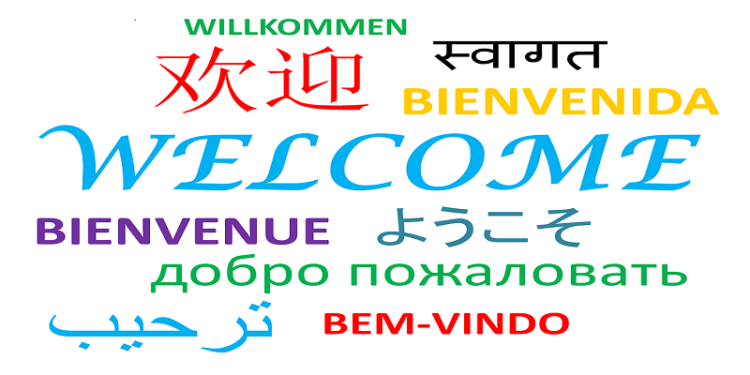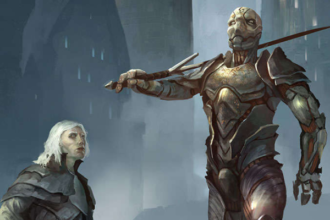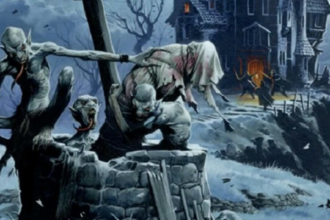Developing a Language for Your Game

(Author’s note: The idea for this article came about when I was talking with some people on a social media site. I hope you enjoy it!)
Tabletop RPGs are filled with races and many times their languages fall into one of several recognizable categories: elf, dwarf, gnome, and so on for PCs, and things like infernal, draconic, and celestial for NPCs (at least in D&D). PCs who know how to read or write a particular language typically handwave what they’re doing. They say “I speak this” or “I read that.” But what happens when you:
- Want to run a language-based mystery?
- Are presenting the party with a long-dead language?
- Create a monster that has another language the PCs either do not know?
- Want to use a language that isn’t translatable via magic? OR
- Want to add depth to your campaign by creating a language that can make your campaign feel alive?
In any of these circumstances, you need to develop a language.
What is a language?
A pared-down Wikipedia definition would be:
Language is a system that consists of the development, acquisition, maintenance, and use of complex systems of communication. Natural languages are spoken or signed, but any language can be encoded into secondary media using auditory, visual, or tactile stimuli – for example, in writing, whistling, signing, or braille. Philosophically, “language” refers to the cognitive ability to learn and use systems of complex communication. It also can be used to describe the set of rules that makes up these systems. Finally, it can be the utterances that can be produced from those rules. All languages rely on the relationship of signs to meanings. Oral, manual, visual, and tactile languages contain systems that govern how symbols are used to form sequences known as words or morphemes and a syntactic system that governs how words and morphemes are combined to form phrases and utterances.
Who or What has Language?
Typically, sociologists and scientists view language as a “human-only” activity. This is a fallacy, however. Animals can communicate, albeit at a different level than we do. Dogs wag their tails to indicate they’re happy. Angry cats arch their backs and hiss. Many species of males fight over territory and females. These same males, after they’ve won the battle, approach the female they were fighting over. Females (typically) show receptiveness to mating initiation after the male wins. Even AI bots have created a language, a corrupted form of English.
Do I even need to create a language?
Before starting a language, DMs need to determine if they need to create a language. There are a variety of free resources on the internet to fill your fantasy language needs. If any of these links fill the needs of your setting, there’s no need to reinvent the wheel.
- Elven (Link 1) (Link 2) (Link 3) (Link 4) (Link 5)
- Dwarven (Link 1) (Link 2) (Link 3) (Link 4)
- Gnomish (Link 1) (Link 2) (Link 3)
- Klingon (Link 1) (Link 2)
- Drow (Link 1) (Link 2) (Link 3)
- Fonts
Do I still need to create a language?
If you’ve gone through these links and still need something else, ask yourself the following questions:
- How is the language going to be used?
- Is the language going to be used as something that needs to be deciphered? If so, you need to create a word list. A classic fictional example of this is the Twilight Zone episode “To serve man.”
- Is the language still being used today? Is this language something you want your players to be able to speak? Then it should be easy to memorize or improv. It should follow the same patterns as real speech.
- Is it going to sound legal and formal? Maybe a cue could be taken from the courtly speech of old.
- Is the language only going to be used for curse words and phrases?
- Can anyone learn the language, or is it only for the initiated? For instance, the speech of the druids or thieves cant.
- Is it a magical language? Can others who don’t have magic understand it even at a basic level?
- Is it a divine language? If so, what happens when those without clerical abilities speak it? Do speakers attract unwanted attention?
- If you’re creating a written language, is it going to use a “standard” font? At least in English, we have a 26-letter alphabet. In other languages, there are variable numbers of letters. In some languages, they don’t have written letters; they have hieroglyphics instead.
- Is the language solely visual? A visual language could be as simple as sign language. Conversely, it could be complicated as body language, position, clothing, and accessories. For instance, a fan can convey many things, without words exchanged. Animals also have the ability to change color, barring of teeth, raising of hackles.
- Visual language II. Semaphore is a visual language all of its own.
- Is the language tactile? If the language uses touch, the roughness, smoothness, sharpness, and so on. If you need a list of words describing sensations you can find some here. Maybe the race has some ability to change its outside to allow others to communicate with it.
Things that affect the language
There are a variety of things that can affect the language.
External Conditions
- What part of the world it’s in. A desert will have many more words for sand and heat. Eskimos have more words for snow and ice because they live in those conditions.
- In the planes, you might run across a separate cant (Link 1) (Link 2) (Link 3)
- Are there even planes? Ravenloft’s residents don’t likely talk about other planes because they don’t know about them.
Culture
- Their religion. A race that reveres one type of deities over another will have a different language. This idea can even be used to make a language for the priests.
- Their diet. A race that doesn’t have access to a specific food won’t talk about it.
- Racial hatreds. In Star Trek and Star Trek: The Next Generation, there is a hatred between the Klingons and Romulans. Their language might very well have proverbs and sayings regarding how they see the other race.
- Technology. A race that is more technologically advanced will have different words for the types of things the tech can do and produce.
- What the race is good at. A race steeped in warfare might have many more words for weapons and armor than one that is peaceful. A race of magicians will have more words on the topic of magic.
- Is the language formal, as in Japanese? How are people who drop the honorifics viewed?
- Another way a language can be formal is in academia. Are the only people who use the language professors and the educated elite?
- Does the language use intonations? If so, how many intonations are there? How embarrassed would a speaker be if they used one intonation over another?
- Is the language such that others haven’t been able to understand it because it’s too alien? This could be why those that interact with the ancient forces in H.P. Lovecraft’s books go insane.
- Is the language too different because of its morphemes and phonologies? An example of this is why the Japanese weren’t able to decipher the Navaho code talkers doing WWII.
Genetics
- The shape of the creature speaking. Not everything is going to be generally humanoid. Some might have a more animal form. The larynx, nose, and mouth shape can all affect the types of vocalizations they can make.
- Do the speakers of the language have other abilities than standard humanoids? How would a species of dolphins talk as compared to a human? How would a flying squirrel communicate as compared to a Pikachu that can say something more than “pika, pika”
Tips For Creating your own language
These tips come from the “Helping Writers Become Authors” blog.
- Don’t get so bogged down in creating a fantasy language that you lose sight of your end goal: drawing players into your fantasy world.
- Jot all language creation notes in one place, keeping a thorough list of invented words.
- List all words and common phrases in alphabetical order. Consider further grouping them in categories like “geographical places” and “curses.” This lets you quickly look up what you’ve used in the past. You could even turn it into a glossary in the back of your novel for your readers’ benefit.
- Add each word or phrase to your word processor’s spell-check tool. This helps you avoid typos or punctuation mistakes that jar the reader out of the experience.
In Conclusion
Languages are an easy way to differentiate your game from a run-of-the-mill experience. Unfortunately, it’s not a walk in the park to create them. You’ll need to figure out whether you need the language, to begin with. If you do, you’ll need to determine whether or not you want to use a script for writing it out. The fonts I listed in this article are an excellent place to start, but feel free to search out your own. But if you decide to do so, you can add mystery to the game for world-building. You can also showcase the race’s humor, curses, abilities, and genetics. Next time you want to add something different to your game, try adding a language.



